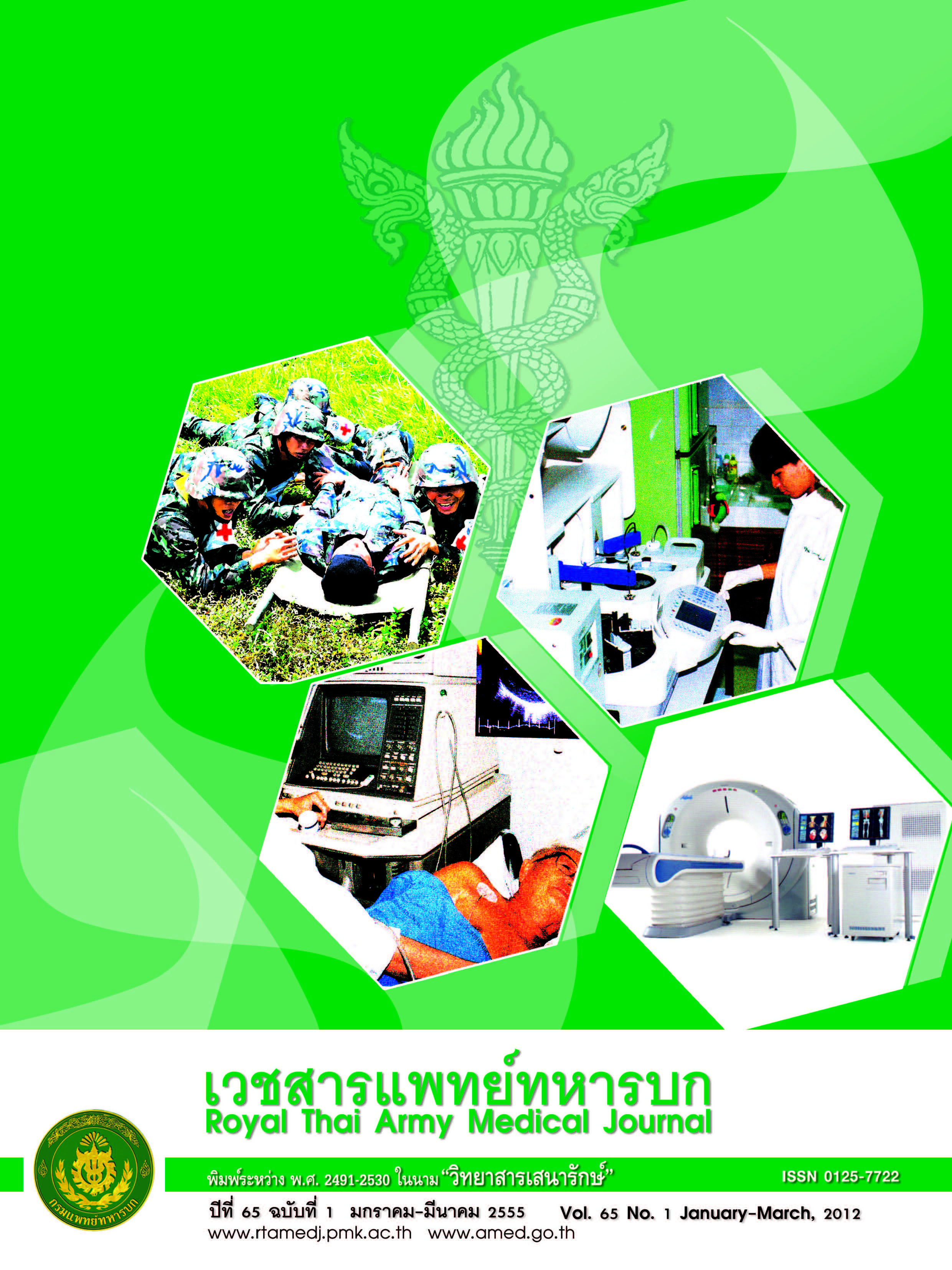ผลของการสอนอย่างมีแบบแผนโดยประยุกต์ใช้ทฤษฎีการเรียนของกาเย่ ต่อระดับความรู้ ความตระหนักและการปฏิบัติตนในการป้องกันโรคไข้หวัดใหญ่ สายพันธุ์ใหม่ 2009 ของหญิงตั้งครรภ์
Main Article Content
บทคัดย่อ
บทคัดย่อ
วัตถุประสงค์: เพี่อศึกษาผลของการสอนอย่างมีแบบแผนต่อความรู้ความตระหนักและการปฏิบัติตนในการป้องกันโรคไข้หวัดใหญ่สาย พันธุ์ใหม่2009 และความต้องการได้รับวัคซีนของหญิงตั้งครรภ์ รูปแบบการวิจัย: การวิจัยกึ่งทดลองสองกลุ่มวัดก่อน-หลัง (Quasi- experimental, two-group pre-post test design) วัสดุและวิธีการ: เลือกหญิงตั้งครรภ์ที่มาฝากครรภ์แบบเจาะจงตามเกณฑ์สุ่ม เข้ากลุ่มทดลองและกลุ่มควบคุม โดยหญิงตั้งครรภ์ที่มาตรวจครรภ์ไนช่วง 2 สัปดาห์แรกจัดเป็นกลุ่มทดลองรวมจำนวน 39 คนและ หญิงตั้งครรภ์ที่มาตรวจครรภ์ไนช่วง 2 สัปดาห์ถัดไปเป็นกลุ่มควบคุมรวมจำนวน 34 คน ให้ตอบแบบสอบถามประเมินความรู้ ความ ตระหนักและการปฏิบัติตนในการป้องกันโรคไข้หวัดใหญ่สายพันธุ์ใหม่ 2009 ที่ได้ผ่านการทดลองใช้และปรับปรุงจนมีค่าความเที่ยงเท่ากับ 0.68, 0.82 และ 0.95 ตามลำดับและตอบแบบสำรวจความต้องการได้รับวัคซีน จากนั้นกลุ่มทดลองได้วับการสอนอย่างมีแบบแผน ส่วนกลุ่มควบคุมได้รับการสอนจากคลินิกตามปกติ ภายหลังการสอน 1 สัปดาห์กลุ่มทดลองและกลุ่มควบคุมได้ตอบแบบสอบถามชุด เดิมอีกครั้งและส่งกลับมาทางไปรษณีย์ครบจำนวนกลุ่มละ 31 คน ผลการรักษา: ก่อนการสอนอย่างมีแบบแผน หญิงตั้งครรภ์ในกลุ่ม ทดลองมีความรู้เรี่องการป้องกันโรคไข้หวัดใหญ่สายพันธุ์ใหม่ 2009 ไม่แตกต่างกับกลุ่มควบคุม แต่พบว่ามีความตระหนักและการปฏิบัติตนในเรื่องดังกล่าวแตกต่างกับกลุ่มควบคุมอย่างมีนัยสำคัญทางสถิติที่ระดับ 0.001 ภายหลังการสอนอย่างมีแบบแผนหญิงตั้งครรภ์ใน กลุ่มทดลองมีความรู้เรื่องการป้องกันโรคไข้หวัดใหญ่สายพันธุ์ใหม่ 2009 สูงกว่าก่อนการสอน และสูงกว่ากลุ่มควบคุมอย่างมีนัยสำคัญ ทางสถิติที่ระดับ 0.001 และ 0.01 ตามลำดับ ส่วนความตระหนักและการปฏิบัติตนนั้นไม่พบความแตกต่างกันระหว่างก่อนและหลัง การสอนของทั้งสองกลุ่ม สำหรับความต้องการในการได้รับวัคซีนนั้น พบว่า ภายหลังการสอนกลุ่มทดลองมีความต้องการได้รับวัคซีน เพิ่มขึ้นจากร้อยละ 48.4 เป็นร้อยละ 61.3 แต่กลุ่มควบคุมมีความต้องการเท่าเดิมคือ ร้อยละ 38.7 เหตุผลที่หญิงตั้งครรภ์ส่วนใหญ่ ไม่ต้องการรับวัคซีน เพราะไม่มั่นใจในประสิทธิภาพและกลัวว่าจะมีผลกระทบต่อตนเองและทารกที่อยู่ในครรภ์ สรุปและวิจารณ์: การสอนอย่างมีแบบแผนโดยประยุกต์ใช้ทฤษฏีการเรียนรู้ของกาเย่ เป็นวิธีการทีมประสิทธิภาพวิธีหนึ่งที่ช่วยเพิ่มพูนความรู้ในการป้องกัน โรคไข้หวัดใหญ่สายพันธุ์ใหม่ 2009 และเพิ่มความต้องการได้รับวัคซีนของหญิงตั้งครรภ์ในครั้งนี้สำหรับความตระหนักและการปฏิบัติ ตนนั้น จำเป็นต้องมีการศึกษารูปแบบที่เหมาะสมและออกแบบการวิจัยที่กลุ่มตัวอย่างในกลุ่มทดลองและกลุ่มควบคุมมีความคล้ายกัน ในทุกตัวแปรที่จะวัด และควรมีการติดตามวิวัฒนาการของวัคซีนเป็นระยะๆ และควรจัดท่าคู่มือเกี่ยวกับการได้รับวัคซีน เพื่อใช้เป็น ข้อมูลประกอบการตัดสินใจของหญิงตั้งครรภ์ต่อไป
คำสำคัญ: ไข้หวัดใหญ่สายพันธุ์ใหม่ 2009 • การสอนอย่างมีแบบแผน • ทฤษฎีการเรียนรู้ของกาเย่ • หญิงตั้งครรภ์
Abstract
Objectives: To study the effects of structural information-giving program applying Gange’s Learning Theory on level of knowledge, consciousness, and practices in preventing 2009 influenza (H1N1) and the need of receiving vaccines among pregnant women. Research design: Quasi-experimental research, two-group pretest-posttest design. Material and Method: Pregnant women undergoing antenatal care at Phramongkutklao Hospital were purposively selected based on the inclusion criteria and were assigned into an experimental and a control groups based on the series of the study in order to avoid contaminating the intervention. After obtaining informed consent, 39 pregnant women in the experimental group and 34 in the control group were asked to fill the questionnaires for pre-evaluating their level of knowledge, consciousness, and practices in preventing 2009 influenza (H1N1) that were validated, tried them out, and adjusted until their reliabilities were 0.68, 0.82, and 0.95 respectively. In addition, they were asked about their need of receiving the vaccine. The experimental group was participated in the structural information-giving program, whereas the control one was received the regular services and mother education from the clinic. One week later, both groups were asked to answer the same questionnaire again by mails and/or by phones to evaluate their knowledge, consciousness, and practices. There were 31 complete questionnaires in each group. The data were analyzed by using descriptive statistics, independent t-test and paired t-test. Results: Before the intervention, the level of knowledge in preventing 2009 influenza in both groups was not significantly different, but the level of consciousness, and practices were statistically different at the significant level of 0.001. After the intervention, level of knowledge in preventing 2009 influenza in the experimental group was better than before and those of the control group at the significant level of 0.001 and 0.01 respectively. The level of consciousness and practices in preventing 2009 influenza was not different. For the need of receiving vaccine after the intervention, it was increasing in the experimental group from 48.4 to 61.3 percentages, whereas in the control group, it remained the same as 38.7 percentages. The reasons for most pregnant women who refused vaccination were that they were not sure about its efficiency and afraid that it could affect oneself and the baby. Discussion: The structural information-giving program by applying Gange’s learning theory was an effective method to increase the level of knowledge in preventing 2009 influenza and enhance the need of receiving vaccination among pregnant woman. For their consciousness and practices in preventing 2009 influenza, it needed an appropriate study to select the similar samples into the experimental and control group in terms of all measured variables before the intervention. For the vaccination, its evolution should be followed periodically and a vaccination guideline should be designed for pregnant women to make a decision to receive the vaccine further.
Key Words: 2009 influenza (H1N1) • Structural information-giving program • Gange’s learning theory • Pregnant women
Downloads
Article Details
บทความในวารสารนี้อยู่ภายใต้ลิขสิทธิ์ของ กรมแพทย์ทหารบก และเผยแพร่ภายใต้สัญญาอนุญาต Creative Commons Attribution-NonCommercial-NoDerivatives 4.0 International (CC BY-NC-ND 4.0)
ท่านสามารถอ่านและใช้งานเพื่อวัตถุประสงค์ทางการศึกษา และทางวิชาการ เช่น การสอน การวิจัย หรือการอ้างอิง โดยต้องให้เครดิตอย่างเหมาะสมแก่ผู้เขียนและวารสาร
ห้ามใช้หรือแก้ไขบทความโดยไม่ได้รับอนุญาต
ข้อความที่ปรากฏในบทความเป็นความคิดเห็นของผู้เขียนเท่านั้น
ผู้เขียนเป็นผู้รับผิดชอบต่อเนื้อหาและความถูกต้องของบทความของตนอย่างเต็มที่
การนำบทความไปเผยแพร่ซ้ำในรูปแบบสาธารณะอื่นใด ต้องได้รับอนุญาตจากวารสาร


